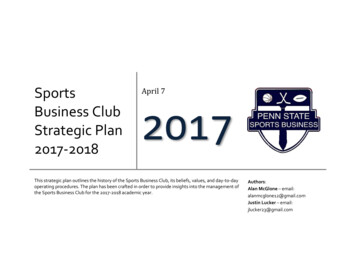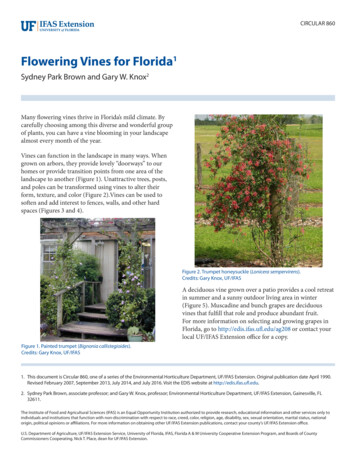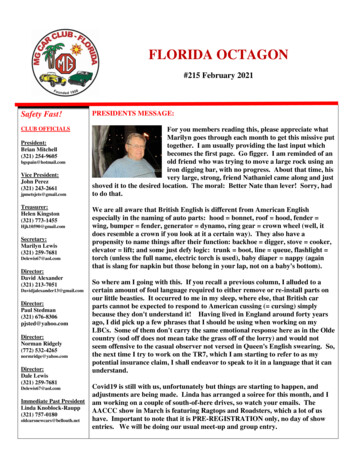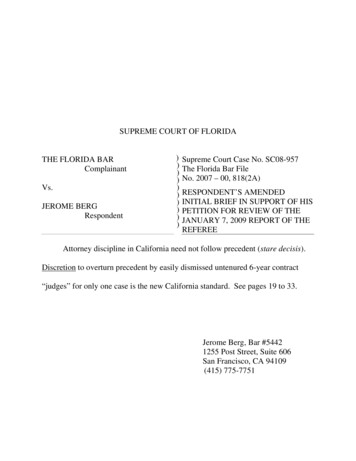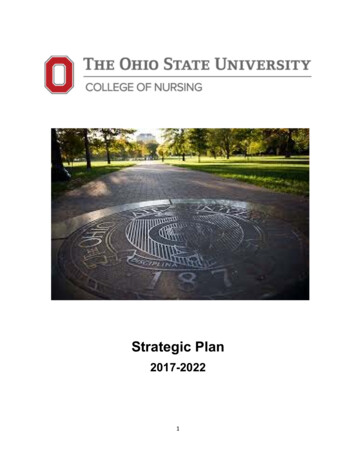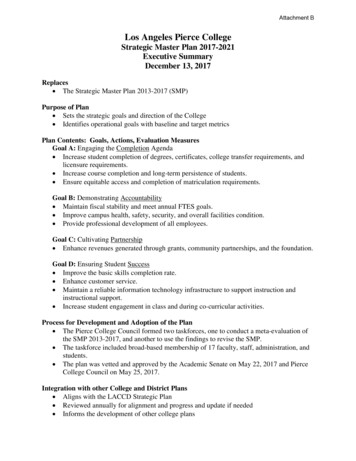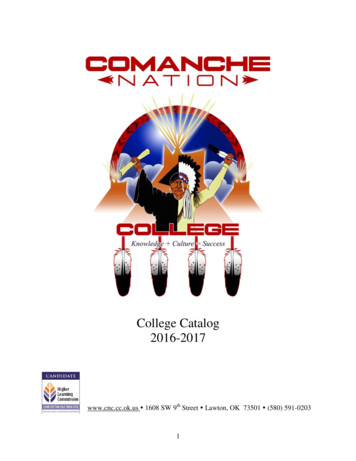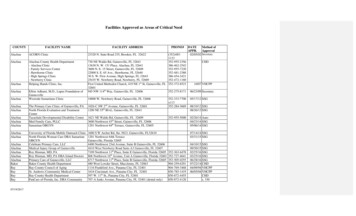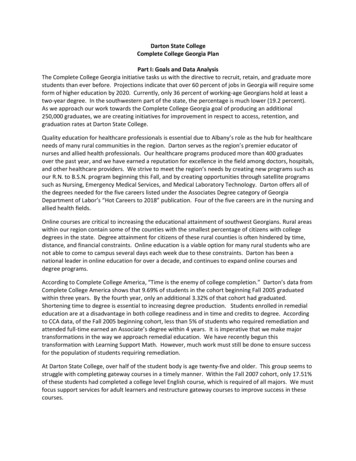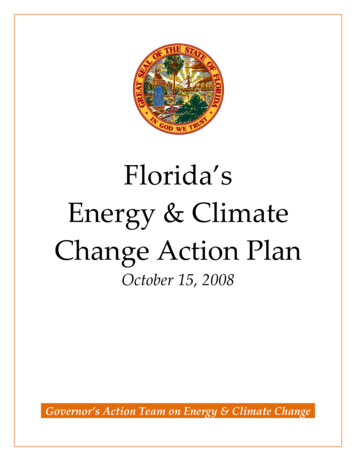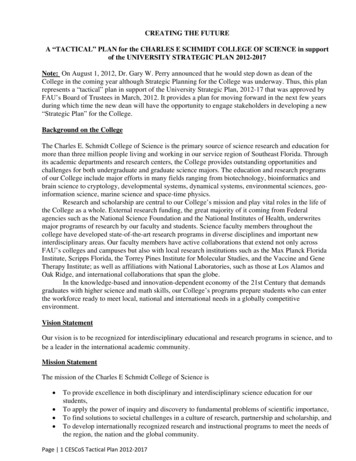
Transcription
CREATING THE FUTUREA “TACTICAL” PLAN for the CHARLES E SCHMIDT COLLEGE OF SCIENCE in supportof the UNIVERSITY STRATEGIC PLAN 2012-2017Note: On August 1, 2012, Dr. Gary W. Perry announced that he would step down as dean of theCollege in the coming year although Strategic Planning for the College was underway. Thus, this planrepresents a “tactical” plan in support of the University Strategic Plan, 2012-17 that was approved byFAU’s Board of Trustees in March, 2012. It provides a plan for moving forward in the next few yearsduring which time the new dean will have the opportunity to engage stakeholders in developing a new“Strategic Plan” for the College.Background on the CollegeThe Charles E. Schmidt College of Science is the primary source of science research and education formore than three million people living and working in our service region of Southeast Florida. Throughits academic departments and research centers, the College provides outstanding opportunities andchallenges for both undergraduate and graduate science majors. The education and research programsof our College include major efforts in many fields ranging from biotechnology, bioinformatics andbrain science to cryptology, developmental systems, dynamical systems, environmental sciences, geoinformation science, marine science and space-time physics.Research and scholarship are central to our College’s mission and play vital roles in the life ofthe College as a whole. External research funding, the great majority of it coming from Federalagencies such as the National Science Foundation and the National Institutes of Health, underwritesmajor programs of research by our faculty and students. Science faculty members throughout thecollege have developed state-of-the-art research programs in diverse disciplines and important newinterdisciplinary areas. Our faculty members have active collaborations that extend not only acrossFAU’s colleges and campuses but also with local research institutions such as the Max Planck FloridaInstitute, Scripps Florida, the Torrey Pines Institute for Molecular Studies, and the Vaccine and GeneTherapy Institute; as well as affiliations with National Laboratories, such as those at Los Alamos andOak Ridge, and international collaborations that span the globe.In the knowledge-based and innovation-dependent economy of the 21st Century that demandsgraduates with higher science and math skills, our College’s programs prepare students who can enterthe workforce ready to meet local, national and international needs in a globally competitiveenvironment.Vision StatementOur vision is to be recognized for interdisciplinary educational and research programs in science, and tobe a leader in the international academic community.Mission StatementThe mission of the Charles E Schmidt College of Science is To provide excellence in both disciplinary and interdisciplinary science education for ourstudents,To apply the power of inquiry and discovery to fundamental problems of scientific importance,To find solutions to societal challenges in a culture of research, partnership and scholarship, andTo develop internationally recognized research and instructional programs to meet the needs ofthe region, the nation and the global community.Page 1 CESCoS Tactical Plan 2012‐2017
College ProductivityThe following Figures provide a trend analysis for the past decade of the increases in the College’sstudent enrollment in both science majors and the annualized FTE, and include a conservative estimateof the projected enrollment in AY 2016-17, when the University Strategic Plan calls for a student bodyat FAU of at least 36,000 students.Figure 1: Total Undergraduate Headcount Majors7,0006,000Total UG headcount5,0004,0003,0002,000As seen in Figure 1, the number ofstudents declaring a science discipline astheir major has doubled in the past decade,through 2010-11, and is projected toalmost treble by 2016-17 based on a 6%student growth rate.1,0000Figure 2: Total annualized FTE from majors and non-majors6,0005,0004,0003,0002,0001,0000Total annualized UG FTEThe total number of students taught bycollege faculty (majors and non-majors),seen in Figure 2, has increased by at least150% through 2010-11 and is projected tobe at least 5000FTE for 2016-17, or abouta 250% increase since 2001-02.Figure 3: Number of TT/TE, non-TT/TE and Adjunct Faculty160140120100Total TT/TE Faculty806040200Page 2 CESCoS Tactical Plan 2012‐2017Total Non‐TT/TEFacultyTotal AdjunctsIn the meantime, thenumber of tenured ortenure-track (TT)faculty has remainedessentially the sameover the past decadewith small increases innon-TT and adjunctsfaculty – see Figure 3.
Process followedThis plan replaces the previous College Plan, 2006-2012 and aligns with the new University StrategicPlan for 2012-2017. The timeline followed in developing this Plan for the College are provided below: In summer 2010, as a prelude to Strategic Planning for 2012‐17, the college began Budget andPlanning exercises which continued into the Fall 2010. A report was produced and presented tothe provost in January 2011. That report is provided below.In summer 2011, a College retreat was held with the college’s executive committee, faculty andmembers of the College’s Science Advisory Board to begin thinking about strategic planningfor the college for the period 2012 ‐ 2017. The retreat was moderated by a professionalmoderator, Ms. Deborah Mason. A summary report of that retreat including Vision/Mission anda SWOTT analysis are provided on the College website.Working with the College’s Executive Committee, a survey conducted by the University’sStrategic Planning Committee was completed in Summer 2011.The University completed its strategic planning process and the BOT approved FAU’s newStrategic Plan 2012‐17 in February 2012.In Fall 2012, the College had two strategic planning meetings. At the meeting on October 10,2012 several work groups were developed and faculty added subsequently to spend the Fallsemester developing reports on Undergraduate Programs, Graduate Programs, Research andCommunity Engagement. Reports from these work groups were compiled by the dean fordiscussion and further modification at the Strategic Planning retreat held on December 12,2012. At this meeting the new Board of Governors Productivity Indicators were discussed andused to modify Goals and Objectives developed by the work groups.In January, 2013, the dean completed a draft of the college plan using the results from priorstrategic planning meetings, as well as the reports from the work groups. The plan proposed ismore a Tactical Plan for the College for the next four years that supports the UniversityStrategic Plan, 2012-17.Draft reviewed by specific members of the planning committee.College Plan approved by faculty assembly on April 25, 2013SWOTT analysis (summary version)The SWOTT analysis revealed many strengths, opportunities and positive trends for the College, whileacknowledging some very real weaknesses and negative trends, probably the most disturbing wasdwindling state and federal funds. Here, the list has been restricted to the four most important in eachcategory.Strengths: Faculty Diverse student body and diverse campuses Partnerships developed with research institutions LocationWeaknesses: Lack of policy development for interdisciplinary programs Shortage of faculty and shortage of research intensive faculty Lack of infrastructure for research and students Inadequate college budgetPage 3 CESCoS Tactical Plan 2012‐2017
Opportunities: Use location to gain national exposure for unique programs Higher profile based on partnerships—state and national--public and private STEM federal support unique on campus among other colleges Work with college of business and engineering to tie to businessesThreats: Lack of adequate predictable funding Retention of best faculty and students Expansion of other institutions into FAU service area Inadequate enlistment of support of local and business communityPositive Trends: Growth of partners and their satellitesSTEM education emphasisDistance learning growingSolutions oriented research versus curiosity based researchNegative Trends: Dwindling federal and state funds Lack of distance learning infrastructure between campuses Increasing number of baccalaureate programs in State Colleges Growth in Ph.D. graduates means more competition for their employmentThe University Strategic Plan, 2012-17In March 2012, Florida Atlantic University adopted a Strategic Plan for the years 2012-17. The planidentifies four principle goals to help guide the University’s direction and strategies in meeting itsmission as “a multi-campus public research university that pursues excellence in its missions ofresearch, scholarship, creative activity, teaching, and active engagement with its communities.” Thefour goals are:I:II:III:IV:Enrich the educational experienceInspire research, scholarship and creative activityIncrease FAU’s community engagementLeverage momentum toward achieving FAU’s strategic goals by being goodstewards of its human, technological, physical and financial resourcesIn addition, the strategic plan outlined three “Signature Themes” that would differentiate FAU’smission and enhance its academic reputation and are intended to raise awareness and attention toareas of University specialization and distinction. The three themes are: Marine and Coastal Issues Biotechnology Contemporary Societal ChallengesClearly, the Charles E Schmidt College of Science and its programs are positioned very well tocontribute in an exciting and meaningful way to the university’s Plan, and indeed will play a criticalrole in its ultimate success.Page 4 CESCoS Tactical Plan 2012‐2017
College Goals, Objectives and StrategiesAny proscribed plan with goals and objectives will necessary, and should, change with prevailingcircumstances, opportunities and uncertainties and hence we view this as a tactical plan, rather than astrategic plan at this time. The following Goals, Objectives and Strategies are for the Charles E SchmidtCollege of Science that will be implemented during the next four years in support of the University’sStrategic Plan, 2012-2017. However, close attention to the University Strategic Plan’s SignatureThemes will govern those areas of the College that will need to be prioritized over other areas of theCollege’s academic and research programs.The Goals, Objectives and Strategies outlined here align closely with the University Strategic Plan andBOG Productivity Indicators that were being considered at the time of planning for future funding.Where indicated, funds will be either new funds as they become available or funds reallocated fromexisting college funds, primarily from E&G funds, Foundation funds or funds recovered throughindirect cost recovery on grants.GOAL I: ENRICH THE EDUCATIONAL EXPERIENCE.Objective A: Enhance quality and expand the undergraduate academic programsStrategy 1: Recruit additional outstanding tenure-track and non-tenure track faculty (High Priority)Metric: Increase in number of tenure-track facultyTimeline:YearNew urce: 80,000S&B per hire plus 300,000 (average) start-up funds/E&GMetric: Increase in number of non-tenure track faculty as needed to meet enrollmentTimeline:YearNew nonTT ce: 70,000S&B per hire/E&GResponsible Party: Provost; Dean; Department ChairsCaveats: The new positions requested here reflect assistant professor or instructor level hires, althoughwhen possible the opportunity may arise to hire more senior individuals.Current salary levels are provided which are no longer competitive with neighboring SUSinstitutions and are certainly not competitive with FAU’s aspirational peers as outlined in theUniversity Strategic Plan who are considered Doctoral/Very High Research ActivityInstitutions.The additional tenure-line positions provided here do not take into consideration the need to hireadditional tenure-track faculty to replace faculty who will retire, or leave the University forPage 5 CESCoS Tactical Plan 2012‐2017
other reasons over the next four years. Given the demographics of the current faculty we canexpect to lose 3-4 tenured faculty members who will need to be replaced. While salary willalready be budgeted, additional start-up funds will be needed for replacement hires.With non-tenure earning hires, ensure that departments do not become overly staffed by nontenure track faculty.The choice of hire(s) will be consistent with University Strategic Plan’s Goals, Objectives andMetrics (I,C,2; II,B,2; III,C,1 & 2; and IV,C,2) and Signature Themes (Biotechnology, Marineand Coastal Issues, and Contemporary Societal Challenges) outlined in the University StrategicPlan, 2012-17.The additional tenure-track faculty must contribute to graduate programs in Goal 2, ObjectiveA, Strategy 1 as well the University’s QEP: Distinction through DiscoveryBudget loss or restrictions will result in failure to add or replace tenure-track faculty which willseverely compromise the quality of the undergraduate and graduate programs, includinggraduate degree production and the success of the QEP, and research productivity.Strategy 2: Increase student advising in the college and develop “Continual Advising Program” forstudents throughout their UG experience (High Priority)Metric: Increase the number of new advisors in the college to NCADDA recommended ratio of300 students for each 162016-172110Metric: Number of students in continual advising (start with less successful students)Timeline:YearStudents 0200025003000Budget/Source: 60,000 S&B per advisor/E&G funds (Total 240,000 E&G)Metric: Number of science majors graduating will increase by 5% per year (currently 152015-162016-17822863907Budget/Source: 10,000 (recruiting/advertising)/E&G reallocated expensesResponsible Party: Senior Associate Dean for Student AffairsCaveats: Additional advisors are needed to adequately reduce the student to advisor ratio in order toeffectively implement a model of continual advising to ensure that each student, and especiallythose at risk, is on track for completion of their degree.Page 6 CESCoS Tactical Plan 2012‐2017
Without additional student advisors, the increasing enrollment will result in less one-on-oneadvising and thus inadequate advising that will result in reduced graduation rates, longer timesto graduation and decreased retention.Strategy 3: Increase Honors-in-the-Major programs in the college (Medium Priority)Metric: Number of “active” Honors-in-the-Major programs (two currently active)Timeline:YearNew ic: Numbers of students in Honors programs will increase by 10% per 162016-17100150175200Budget/Source: 200,000/Scholarships; 20,000 QEP & E&GResponsible Party: Department Chairs; Development Director, DeanCaveats: Honors programs will require students to actively participate in undergraduate research (QEP)and an adequate number of faculty active in honors education and researchInadequate budget or loss or restrictions will result in failure to add new or replace tenure-trackfaculty which will severely compromise the quality of the undergraduate programs, especiallyHonors programs and the success of the QEP.Strategy 4: Increase Undergraduate summer scholarships in the College (Low Priority)Metric: Number of undergraduate summer research undergraduate 2014-152015-162016-1710152025Budget/Source: 5,000 per summer scholarship/Gift Funds; Federal grants; IDC recoveryResponsible Party: Development Director; Chairs; DirectorsCaveat: Need to identify donors willing to support undergraduate summer research scholarships.Page 7 CESCoS Tactical Plan 2012‐2017
Strategy 5: Increase “online” course offerings by 5% per year (High Priority)Metric: Number of online courses [synchronous and asynchronous (80-100% instruction viatechnology) and includes blended/hybrid courses (50-70% instruction via -152015-162016-1734363840Budget/Source: Training 24,000/CeL; Course delivery 48,000/CeL; Faculty assignment/E&GResponsible Party: Associate Provost for eLearning; Department ChairsCaveats: The projected increase in the number of online courses offered by the College is realistic butmay not be sufficient to meet demand and student interest for online learning. Future enrollmentdemand may need to be met with online instruction not only from a standpoint of studentnumbers, but also student preference. Where necessary online courses with a lab component canbe coupled to concentrated periods in teaching labs on one of the three campuses (Boca, Davie,Jupiter) that houses science programs.Current faculty are less apt to engage in online instruction and so need to continue withincentives (salary supplements) from the Center for eLearning (CeL) for faculty to developonline courses. After online courses are developed and have been delivered on several occasionsthen the online course can become part of regular faculty assignment.Non-tenure track hires in Goal 1: Objective 1: Strategy 1 should be hired with the view thatthey will also teach online courses (possibly move lower division courses to online delivery)Objective B: Strengthen and expand graduate programsStrategy 1: Develop additional Bachelor/Master’s (B/M) accelerated programs (includingPSM)(Medium Priority)Metric: Total number of BS/MS or BA/MA programs in the 162016-175788Metric: Number of students in all BS/MS -162016-174575105120Budget/Source: 200,000/E&G (OPS) reallocated teaching assistantshipsResponsible Party: Associate Dean for Graduate Studies; Department ChairsPage 8 CESCoS Tactical Plan 2012‐2017
Caveats: The number of students entering these accelerated programs may be underestimated. As FAU“competes” with state colleges, an advantage that it has in recruiting good students are itsgraduate programs, and the increasing number of students interested in accelerated programssuch as BS/MS or BA/MA programs. This will increase the work load for faculty engaged ingraduate education, but “pays-off” with better students.Accelerated and professional masters programs should also be developed with other colleges,such as Business and Engineering, to increase the job opportunities for students.Strategy 2: Expand graduate training programs that use existing PhD programs in science (eg IBAN)(Medium Priority)Metric: Number of new graduate programs using existing PhD programs (eg IntegrativeBiology and Neuroscience [IBAN] program with Max Planck Florida Institute 4-152015-162016-171111Budget/Source: 200,000/E&G (reallocated teaching assistantships); 25,000 IDC recovery;Responsible Party: Associate Dean for Graduate Studies; Chairs; DeanCaveat: Addition of graduate programs will require more TT research active faculty with researchfunding and additional graduate teaching assistantships/scholarships.Strategy 3: Increase number of affiliate faculty involved in graduate programs (Medium Priority)Metric: Number of affiliate Faculty involved in PhD 13-142014-152015-162016-1712182430Budget/Source: 10,000pp/E&G expensesResponsible Party: Associate Dean for Graduate Studies; Chairs; DirectorsCaveats: Need to demonstrate to affiliate faculty how participation is in their interest too.Affiliate faculty may expect “quid pro quo” compensation for their involvement in grad
Lack of distance learning infrastructure between campuses Increasing number of baccalaureate programs in State Colleges Growth in Ph.D. graduates means more competition for their employment The University Strategic Plan, 2012-17 In March 2012, Florida Atlantic University
